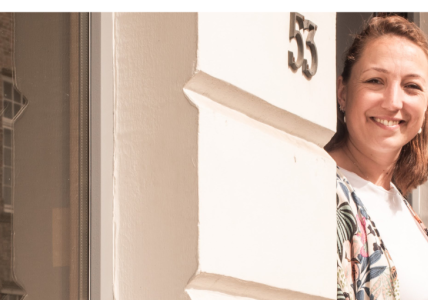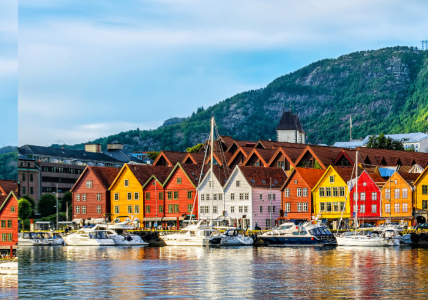Zero Emission Ports North Sea (ZEM Ports NS) helped realise the world's first 100% hydrogen-driven cargo ship. The project also analysed how port infrastructures must prepare for carbon-free shipping.
Who would have thought of a container ship driven purely by hydrogen back in 2019? A few years ago, hydrogen was quite an exotic fuel, especially for ships.
However, the maritime industry has set aims to reduce emissions. Maritime transport accounts for 3 to 4% of the EU's total CO2 emissions, or over 144 million tonnes of CO2 (2019), with a predicted further increase. Container ships contribute 30% to these emissions.
The ZEM Ports NS project facilitated the use of zero emission fuels - electricity and hydrogen - in North Sea Region ports and maritime sectors. We did this by sharing the knowledge developed with stakeholders of the green transition at sea.
Since the maritime sector is inherently international, a transnational approach is essential. This project shared good practices and applied methodologies to reach a successful change in port infrastructures, moving them from fossil to green fuels.
Have you ever travelled on a battery-driven ferry?
Since August 2019, the electric ferry Ellen operates the route Søby-Fynshav in the South Denmark Region. Passengers' satisfaction is very high due to the smooth and quiet ride and the smog-free sundeck. That is not all: Ellen saves CO2 emissions. And in 4-8 years' time, the extra investment will turn into savings due to low maintenance costs.
However, one challenge remains: Charging Ellen with renewable energy. Available local wind energy produced on the island of Ærø needs to match the energy requirements of the ferry through a storage system.
Within ZEM Ports NS, the University of Southern Denmark investigated the energy needs of other users in the harbour and on the island. The aim was to develop an intelligent harbour concept. The researchers simulated different scenarios, analysed flexibilities, and suggested incentives to steer the demand in the electric grid.
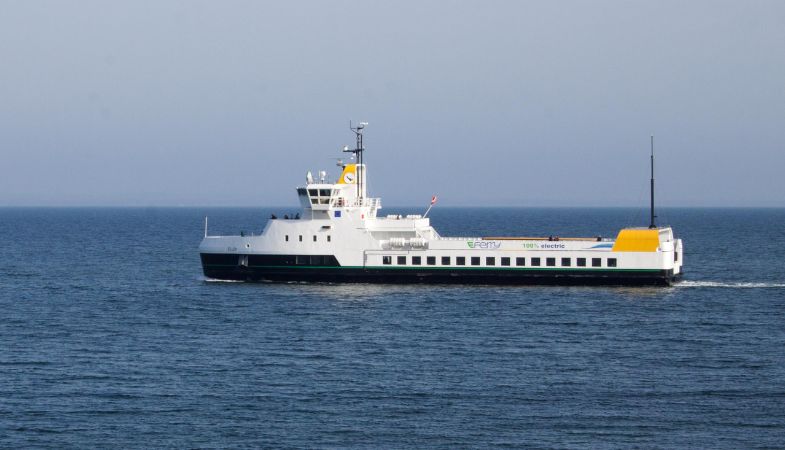
The electric ferry Ellen en route between the island of Ærø and mainland Fynshav. Photo: Ærø Municipality.
Ærø municipality is now part of an operation group for new electric ferries receiving funding from the Danish state. In total, 14 new state-supported electric ferries are planned in the coming years. This outstanding achievement will support Denmark's aims to reduce greenhouse gas emissions by 70% by 2030 compared to 1990 levels.
The manager of the ferry project on Ærø, Cecilie Larsen, is excited about the development:
"Our experience from the EU-funded E-ferry project operationalising the fully electric ferry, E/F Ellen, is precious in the new ferry projects and has left us in no doubt that the new ferries should also be electric," she says.
"The municipality's involvement in the ZEM Ports NS project has given us important insights into the crucial land-based infrastructure that electric ferries entail. The analyses and simulations have prepared us to ensure a good interplay between land and sea. We are also prepared to reap advantages by taking the broader ports environment into account when planning charging and grid connectivity."

The locations of new planned e-ferries in Denmark.
First container ship running 100% on hydrogen
While energy storage is important for ships powered by electricity, swap of hydrogen containers, onsite hydrogen production, and safety are key factors for hydrogen-driven ships.
The best way to increase the use of zero-emission hydrogen-fuelled vessels is to push the development of these ships/ferries as well as port-side fuelling and hydrogen storage infrastructure.
Thanks to the Interreg North Sea Programme and other supporters, our partner Future Proof Shipping (FPS) was able to advance toward a hydrogen-driven vessel. The challenges were many:
- Should one build new hydrogen-driven ships or retrofit existing diesel ships?
- Where to store the energy on the ship?
- How much hydrogen would be needed for a container ship?
- Is port side infrastructure for refuelling available?
- Are regulations and safety measures mature enough?
Over time FPS transformed from an engineering consulting company to a ship-owning company with a single ship. Since then, they have expanded to three ships, with plans to expand further.
We started as a consultancy to help ship and cargo owners get to zero, and somewhere along the way, we ourselves became a shipowner to prove it could be done.
A double world first
One ship was successfully retrofitted to become a hydrogen-driven vessel. This was done with substantial contributions from ZEM Ports NS covering essential equipment. Our project also supported FPS's safety study and monitoring of the vessel's emissions performance.
A fantastic launch event on May 25-26, 2023, gathered about 400 people. The H2 Barge 1 is the world's first container ship running 100% on hydrogen. And since it uses only green hydrogen, it is also the world's first emission-free container ship.
The launch was attended by the Dutch Minister of Infrastructure and Water Management who presented FPS founder Huib van de Grijspaarde with a special label awarded only to zero-emission vessels. This label is a Dutch initiative that hopes to expand to the European level.
It is my pleasure to present the very first A-Zero emission label to H2 Barge 1, as it is the first vessel to truly qualify as zero-emission.
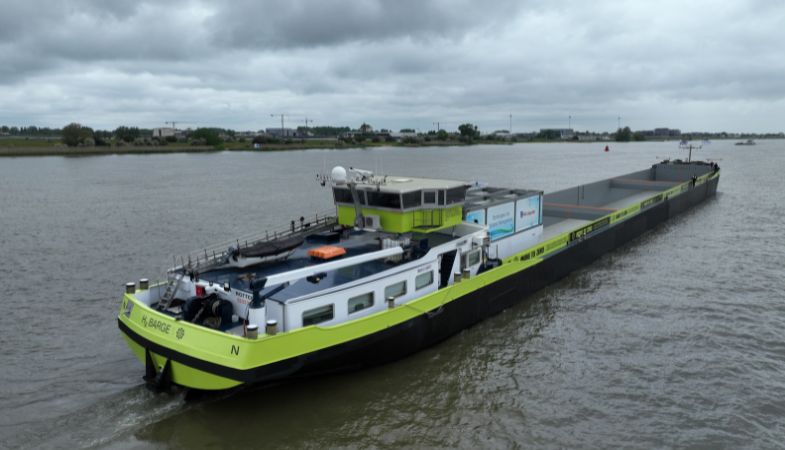
The H2 Barge 1 on her maiden voyage, running exclusively on hydrogen. Photo: Future Proof Shipping.
The retrofit involved collaborating with numerous stakeholders. Planning and obtaining regulatory approvals took nearly 2 years, while retrofitting work at the yard took another year from dry docking to commissioning.
The second FPS ship will complete the same procedure in just six months for approvals, and 4 months for retrofitting at the yard with further improvements expected for future vessels. NS ZEM Ports produced a couple of whitepapers with key findings which you can find in our output library.
Mobile hydrogen refuelling
At Pure Energy Centre, they thought about the shore side supply and safety for hydrogen. They built a mobile fuelling station for the production and storage of hydrogen and trained staff to use it.
This aligns with findings from the Interreg North Sea project HyTrEc2 in 2022, showing that it is beneficial to produce hydrogen locally and avoid transportation over long distances. The refuelling station of PURE Energy Centre is a fully operating demonstrator with production and storage of hydrogen inside a container. It can thus be transported easily to different places to produce hydrogen and train people on its safe use.
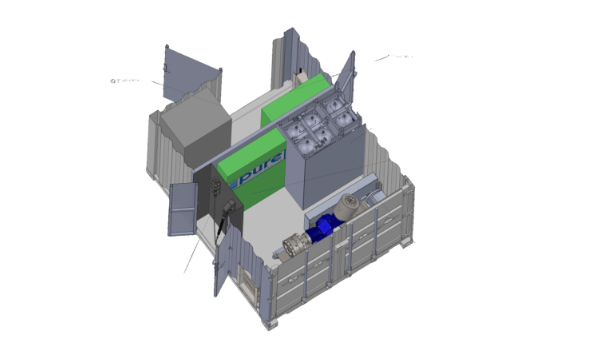
The concept used in PURE Energy Centre's hydrogen refuelling station. Image: Pure Energy Centre.
Change takes courage and funding
The maritime industry is undergoing a significant shift as alternative fuels like electricity and hydrogen are gaining momentum.
However, undertaking large-scale projects like electric ferries and hydrogen container vessels demands substantial external funding and individuals with the courage and determination to initiate and oversee such a venture.
The success stories of these technologies are only possible due to the dedication of people who have found support from forward-thinking organisations willing to invest at a stage when success was not predictable.
Top three project highlights
Optimising energy needs in ports
The project analysed port infrastructure and energy distribution of energy, discovering how to optimise demand and production of green energy.
World's first hydrogen-driven cargo ship
H2 Barge 1 is the world's first container vessel running purely on hydrogen and also the first to use green hydrogen only, making it emission-free. This will save 2,000 tons of CO2 each year.
Mobile refuelling station
It is important to produce the hydrogen where it is needed. The mobile refuelling station developed through ZEM Ports NS can be used for on-site testing and supply in ports.
Learn more
Learn more about ZEM Ports NS at the project website:
Dive into the project's documents to learn more abut the different aspects of the project. You can find the following and more in the project's output library:
- Towards a 100% renewable island power system with energy storage: Modelling, optimisation, and cost analysis.
- Operational profile measurements of an inland container vessel and sizing of fuel cells and hydrogen storage.
- CO2 footprint and life cycle analysis of inland vessels powered with renewable technologies.
- Assessment of the scalability of (hydrogen) retrofit solutions as a greening solution across the inland waterway fleet.
- Analysis of the port infrastructure for new E-ferries.
- Hydrogen refuelling solutions for the H2 Barge 1 and FPS Waal.
Get in touch
Contact ZEM Ports NS project manager Katharina Rubahn:
Email: kru@tek.sdu.dk
About the author

Katharina Rubahn coordinated the ZEM Ports NS project. She works for the University of Southern Denmark as a project coordinator. Her focus is on technical and sustainable projects.
Top photo: Peter Racz /Interreg North Sea Joint Secretariat
